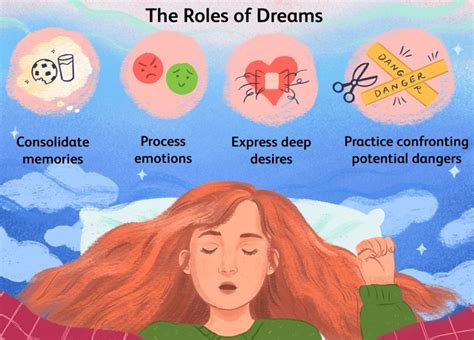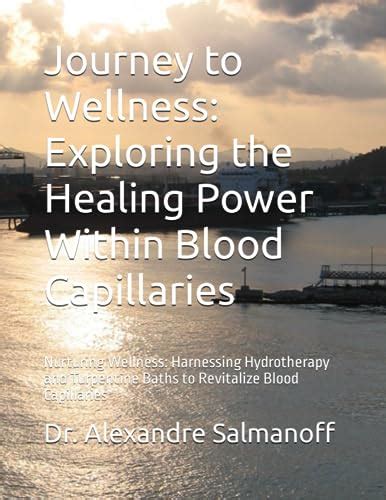Within the depths of human consciousness lies a realm untouched by the constraints of reality. It is a sanctuary, where the weary soul finds solace, escaping the burdens of existence and embracing the ethereal. In this domain of imagination and vulnerability, lies the embodiment of dreams.
Through the veil of the mundane, dreams can manifest as vibrant tapestries, whispering stories untold and emotions unfelt. They possess the power to transport minds to places unseen, where the ordinary is transformed into the extraordinary. These extraordinary realms become a refuge for the weary spirit, offering solace and respite from the trials of life.
Like an elusive key, dreams unlock hidden chambers within the labyrinth of the human psyche. They paint portraits of desires and aspirations, revealing the deepest longings of the heart. In this secret world, where the boundaries of time and space fade away, dreams give voice to the inexpressible, expressing thoughts and emotions that often lay concealed within the recesses of the wounded soul.
Within the context of a wounded existence, dreams become more than mere flights of fancy. They hold immense power, providing a sanctuary where pain and sorrow are transmuted into hope and resilience. In these nocturnal wanderings, a wounded individual can find refuge, where the limitations of their physical being are dissolved, and a renewed sense of purpose is discovered.
Dreams of Traumatized Souls

In this section, we explore the profound inner experiences of individuals who have suffered psychological wounds and the unique dreams that emerge from their traumatized souls. These dreams reveal a vivid tapestry of emotions, perceptions, and desires, serving as windows into the depths of their subconscious minds.
Through a variety of symbolic representations and metaphors, the dreams of traumatized souls provide a space for healing, reflection, and catharsis. They hold the potential to unlock repressed emotions, uncover hidden truths, and offer a glimpse into the inner journey of those who have endured profound pain and suffering.
| Section | Description |
|---|---|
| The Language of Dreams | Exploring the unique symbolism and imagery that permeates the dream world of traumatized souls, deciphering the hidden meanings and messages that these dreams convey. |
| Emotional Landscapes | Examining the intricate landscapes of emotions that manifest in the dreams of traumatized souls – from fear and despair to resilience and hope – and how these emotional journeys contribute to the healing process. |
| Navigating Nightmares | Delving into the realm of nightmares and understanding their significance in the dreams of traumatized souls, exploring the potential for transformative growth and the integration of past trauma. |
| The Power of Symbolism | Unraveling the rich symbolism that permeates the dreams of traumatized souls, investigating how archetypes and metaphors provide profound insights into the psychological landscapes of healing and recovery. |
By delving into the dreams of traumatized souls, we aim to shed light on the profound inner processes that occur within individuals who have experienced trauma and ultimately inspire empathy, understanding, and support for their healing journeys.
Exploring the Psychology of Dreams in the Context of Emotional Trauma
In this section, we delve into the intricate landscapes of the sleeping mind, unraveling the hidden narratives that unfold within the subconscious realm of individuals who have experienced emotional trauma. By examining and analyzing the dreams of those who have been profoundly affected by distressing events, we aim to gain a deeper understanding of the psychological processes that underlie these nocturnal journeys.
Within the delicate fabric of the human psyche, dreams serve as powerful conduits for emotional processing and healing. Drawing upon the rich tapestry of symbols, metaphors, and allegories, the wounded soul seeks solace and resolution within the intricate realm of dreaming. These dreams provide invaluable insights into the depths of human emotions, encapsulating the essence of pain, resilience, and the potential for psychological growth.
Unfolding the Rhythms of Nightmares: Within the realm of dreams, nightmares often take center stage, showcasing the unhealed wounds of emotional trauma. By examining the recurring themes, vivid imagery, and physiological responses associated with these distressing dream experiences, we begin to unravel the intricate web of emotional pain and unresolved conflicts.
The Language of Symbols: Dreams of wounded individuals often present a diverse array of symbols and archetypes that weave together into intricate narratives. These symbols serve as potent psychological representations, reflecting deep-seated emotions, fears, and desires. By decoding the symbolic language of dreams, we can gain invaluable insights into the wounded individual's unique psychological landscape.
Healing and Transformation: Dreams also offer a glimpse into the potential for healing and transformation. Conversely, they may serve as poignant reminders of the ongoing journey towards emotional recovery. By examining the dreams of wounded individuals, we aim to shed light on the intricate processes of healing and growth that unfold within the realm of the sleeping mind.
Through this exploration of dreams in the context of emotional trauma, we hope to foster a deeper understanding of the psychological challenges faced by wounded individuals. By unraveling the symbolism and narrative elements within these dreams, we gain valuable insights into the intricacies of the human psyche and the potential for emotional healing and transformation.
The Restorative Influence of Dreams

Within the realm of human consciousness, there exists a hidden path towards rejuvenation and recovery, where the intangible whispers of dreams weave a tapestry of solace and healing. In its ethereal nature, dreams possess the incredible power to offer solace, guidance, and empowerment, allowing individuals to navigate the tumultuous landscapes of their wounded souls. Through this profound self-discovery, dreams serve as a conduit for reshaping perspectives, restoring hope, and igniting the flame of resilience that resides within each unique being.
- 1. Portals of Insight:
In the realm of dreams, doors unlock to reveal the deepest recesses of our subconscious minds. Each dream is an opportunity to gain insight into the wounds that we carry, providing a lucid glimpse into the intricacies of our emotional landscapes. As we decode the symbolism inherent in our dreams, we unravel the threads of our pain, allowing us to confront, process, and ultimately heal the wounds that have long plagued our being.
- 2. Navigating the Desolate Terrain:
In the midst of our wounded existence, dreams become lanterns that guide us through the desolate terrain we traverse. Through vivid narratives and surreal imagery, dreams offer solace and a sense of direction, leading us towards the path of recovery. They become beacons of light, illuminating the darkest corners of our wounded souls, drawing us closer to a place of wholeness.
- 3. Whisperers of Hope:
Even amidst the turmoil of our woundedness, dreams have an innate ability to breathe life into the embers of hope. They carry messages of resilience, reminding us of our innate strength and the capacity for transformation that lies within us. Dreams become messengers of hope, encouraging us to continue our journey of healing, assuring us that we possess the strength needed to rise above our wounds and create a future filled with renewed purpose.
- 4. Manifestations of Empowerment:
As dreams unfold, they provide opportunities for individuals to seize control of their wounded narratives. In the realm of dreams, one can rewrite the script of their suffering, transforming themselves from wounded victims to empowered survivors. Through lucid dreaming and conscious intention, dreams allow individuals to reclaim their power, utilizing the healing energy within them to transcend the limitations imposed by their wounds.
In essence, dreams hold the key to unlocking the potential for healing within us. Through their mystical language, dreams provide solace, guidance, and empowerment, offering wounded individuals a pathway towards wholeness and restoration. The healing power of dreams transcends the boundaries of the conscious mind, granting us the opportunity to rewrite our wounded narratives and embark on a journey of profound transformation.
The Healing Power of Dream Exploration
Within the realm of personal growth and recovery, there exists a profound tool that aids in the journey towards healing and self-discovery. This transformative tool has the ability to unlock hidden emotions, provide insights into unresolved trauma, and assist in the process of healing wounds that have been inflicted upon the psyche. Although often overlooked and underestimated, dreams serve as messengers from the unconscious mind, guiding individuals towards the path of recovery and restoration.
Unveiling the Veiled: Dreams possess an extraordinary capacity to reveal thoughts and emotions that have been buried deep within the recesses of the mind. They provide a space for the wounded soul to express and process experiences that have been obscured or repressed, offering an opportunity for catharsis.
Shedding Light on the Shadows: Dreams act as a beacon, illuminating the dark corners of the subconscious that harbor unresolved trauma. Through symbolism and metaphor, dreams bring attention to hidden wounds, allowing individuals to confront their pain and embark on the path to healing.
Integrating Fragmented Experiences: Trauma often fragments the sense of self, leaving individuals feeling disjointed and disconnected. Dreams play a vital role in consolidating these fragmented experiences, allowing individuals to make sense of their past, understand their present, and envision a future that is whole.
Empowering the Individual: The exploration of dreams fosters a sense of empowerment in the wounded individual. By actively engaging with their dreams, individuals gain a sense of control over their healing process, transforming from passive recipients of trauma to active participants in their own recovery.
Embracing Hope and Resilience: Dreams offer a glimmer of hope in the face of despair and hardship. They provide glimpses of the possibilities for growth, resilience, and transformation, offering a guiding light towards healing and the restoration of the wounded individual's spirit.
Overall, dreams serve as an integral component in the recovery journey of individuals who have experienced trauma. By exploring and interpreting the messages embedded within dreams, the wounded individual embarks on a profound process of self-discovery, self-empowerment, and healing, ultimately leading them towards an awakened state of wholeness and well-being.
Recurring Nightmares: A Glimpse into Trauma

In the realm of slumber, when the mind wanders into the nocturnal landscapes, there lies a visceral realm where distress and torment intertwine. The haunting chronicles that unfold in the nightly visions of certain individuals provide a window into the depths of trauma experienced within. Far from simple dreams, these recurring nightmares offer a profound glimpse into the shattered psyche, revealing the lasting impact of past events on the subconscious mind.
Within the labyrinth of the wounded soul, these nightmarish episodes serve as a relentless reminder of the anguish and suffering endured. They manifest as vivid recollections of past horrors, rendering a harrowing narrative that escapes the boundaries of rationality. Each occurrence, with its disorienting intensity, brings forth a chilling portrayal of the underlying wounds that lay buried beneath the surface.
These recurring nightmares serve as an involuntary invitation into the traumatic experiences that have left an indelible mark on the individual's existence. Their distorted landscapes, populated with symbols and imagery charged with emotional significance, act as a conduit through which suppressed memories and unresolved conflicts resurface, demanding acknowledgement and resolution.
Moreover, these recurring nightmares bear witness to the enduring nature of trauma, as they haunt the subconscious night after night, creating a cycle of torment that reflects the ongoing struggle of the wounded psyche to heal and find solace. They hold a mirror to the deeper underlying wounds, highlighting the urgency for therapeutic intervention and the need to navigate the path towards inner wholeness.
By delving into the study of these recurring nightmares, researchers and psychologists gain a unique vantage point into the residual effects of trauma on the human mind. Within these disturbing visions lie valuable insights into the processes of trauma recovery and the intricate workings of the wounded individual's attempt to restore equilibrium.
Ultimately, these recurring nightmares offer more than a glimpse into the trauma suffered by the individual; they unveil a labyrinth of emotions, memories, and psychological patterns that require careful exploration and understanding. Through the lens of these haunting dreams, a path towards healing and transformation can be illuminated, providing hope for those who yearn for liberation from their wounded past.
The Meaning Behind Repetitive Imagery in Afflicted Souls
What lies beneath the surface of a reoccurring dream can reveal a subliminal message embedded within the psyche of those who have endured deep emotional pain. These visions, which echo continuously through the slumber of those affected, hold a deep significance in unraveling the innermost struggles and yearnings of individuals who have experienced profound suffering.
Repeated symbolism within these dreams serves as a portal into the wounded mind, expressing the unspoken desires, fears, and hopes that have been suppressed or buried deep within. Each vivid image, each fleeting scene that reappears relentlessly, carries a weighty emotional charge, forging a connection between the wounded individual and their subconscious world.
The significance of these recurring dreams lies in their ability to bypass the conscious mind, providing a glimpse into the deepest recesses of one's soul. Rather than being mere random imaginings, they act as a magnifying glass, highlighting patterns and themes that are often overlooked or ignored during waking hours.
Through the lens of repetition and variation, these dreams offer a unique perspective on the individual's journey of healing and self-discovery. The reoccurrence serves as a signal, urging the afflicted soul to pay attention to the emotions and experiences represented within the dreamscapes.
By delving into the significance of repetitive dreams, one can unveil the underlying psychological wounds that have shaped and defined the individual's existence. Each dream fragment that returns holds the potential for unlocking a deeper understanding of the wounded individual's innermost desires, providing a pathway towards self-realization and ultimate recovery.
It is within the repetition of these dreams that the healing process can truly begin. The transformative power embedded within their reoccurring nature offers an opportunity for the wounded individual to face their fears, confront their pain, and ultimately emerge stronger, whole, and ready to embrace a future that transcends the limitations of past traumas.
Exploring the Healing Power of Dreams

In the realm of psychological recovery, dreams serve as a therapeutic tool to aid individuals in their path to personal growth and healing. By tapping into the subconscious world of dreams, individuals can embark on a journey of self-reflection and self-discovery, uncovering hidden emotions and unresolved issues through symbolic representations. Through the exploration and interpretation of these dream symbols, individuals can gain valuable insights into their wounded psyche, paving the way for healing and transformation.
1. Unveiling the Unconscious: Dreams provide a unique window into the unconscious mind, offering glimpses of thoughts, desires, and fears that may not be easily accessible during waking hours. By delving into the rich symbolism of dreams, individuals can gain a deeper understanding of their emotional struggles and wounds, uncovering the underlying causes behind their pain.
2. Symbolic Language: Dreams communicate through a language of symbols, providing a metaphorical representation of one's innermost thoughts and emotions. Paying attention to recurring symbols and themes within dreams can guide individuals towards a better understanding of their wounded self, allowing them to process and heal unresolved trauma or distressing experiences.
3. Emotional Catharsis: Dreams often act as a channel for emotional release, offering individuals the opportunity to express and process their feelings in a safe and non-judgmental space. Within the realm of dreams, individuals can explore intense emotions, confront their fears, and find solace in the cathartic experience that dream analysis can bring.
4. Integration and Transformation: Through dream work, individuals can integrate and assimilate the insights gained from their dreams into their waking life. By actively engaging with and reflecting upon the symbols and messages presented within their dreams, individuals can initiate transformative changes, leading to personal growth, enhanced well-being, and the healing of their wounded psyche.
Embracing dreams as a therapeutic tool allows wounded individuals to embark on a profound journey of self-discovery, providing valuable insights, emotional catharsis, and a pathway towards healing and transformation. By harnessing the power of dreams, individuals can unlock the potential for growth and cultivate a deeper understanding of their wounded selves, paving the way for a brighter and more fulfilling future.
Exploring the Role of Dream Interpretation in Healing Trauma
Within the context of the topic "Dreams of a Wounded Individual", this unique article section delves into the valuable utilization of dream analysis as a tool for trauma healing. Reflecting on the deep inner experiences of those who have endured emotional or physical wounds, dream analysis offers a nuanced approach to understanding and addressing the effects of trauma.
Diving into the realm of dreams, this section explores the significance of decoding the symbolic language of the unconscious mind. By examining the metaphors, symbols, and narratives presented in dreams, individuals can gain insights into their own trauma-related experiences, allowing for a deeper exploration of the wounded psyche.
Integrating dream analysis into trauma healing practices not only facilitates personal growth, but also aids in the development of coping strategies and self-awareness. By uncovering hidden emotions, desires, and unresolved conflicts through dream interpretation, individuals can begin to process and heal from their trauma in a transformative way.
| Benefits of Utilizing Dream Analysis in Trauma Healing: |
|---|
| 1. Enhanced self-reflection and introspection |
| 2. Identification of recurring patterns and themes |
| 3. Uncovering subconscious fears and anxieties |
| 4. Facilitating emotional release and catharsis |
| 5. Strengthening resilience and coping mechanisms |
Through the exploration of dreams, the wounded individual can secure a newfound sense of agency and empowered ownership over their healing process. Dream analysis offers a profound way to tap into the subconscious, creating a bridge between trauma and transformation.
FAQ
What is the article "Dreams of a Wounded Individual" about?
The article "Dreams of a Wounded Individual" explores the dreams and aspirations of a person who has experienced emotional or physical trauma.
How does trauma affect a person's dreams?
Trauma can have a profound impact on a person's dreams. It can lead to vivid nightmares, recurring themes, or even a complete absence of dreams. Traumatic experiences often manifest themselves in the subconscious mind during sleep.
Can dreams help wounded individuals in their healing process?
Yes, dreams can play a crucial role in the healing process of wounded individuals. Analyzing and understanding the symbolism within dreams can provide insights into unresolved issues or emotions that need to be addressed. Dreams can serve as a therapeutic tool for self-discovery and growth.
Are there any specific types of dreams that wounded individuals commonly experience?
Wounded individuals often experience recurring dreams related to their trauma. These dreams may involve reliving the traumatic event or situations that symbolize their emotional pain. Additionally, wounded individuals may have dreams that reflect their desire for healing, such as dreams of liberation or transformation.
What can be done to promote healing through dreams for wounded individuals?
Several methods can help promote healing through dreams for wounded individuals. Keeping a dream journal, working with a therapist or dream analyst, practicing relaxation techniques before sleep, and engaging in activities that promote emotional well-being can all contribute to the healing process. It's important to create a safe and supportive environment for exploring and deciphering the messages within dreams.
What is the article "Dreams of a Wounded Individual" about?
The article "Dreams of a Wounded Individual" explores the dreams experienced by individuals who have suffered physical or emotional wounds, and how these dreams may differ from those of a healthy person.



